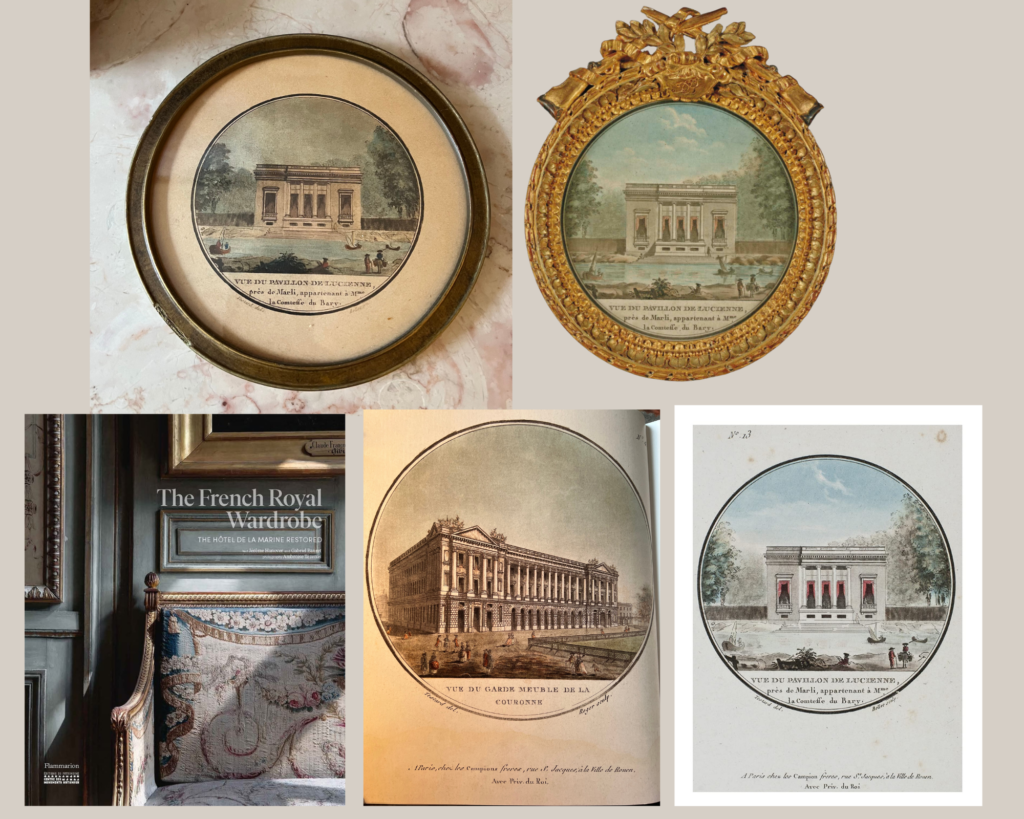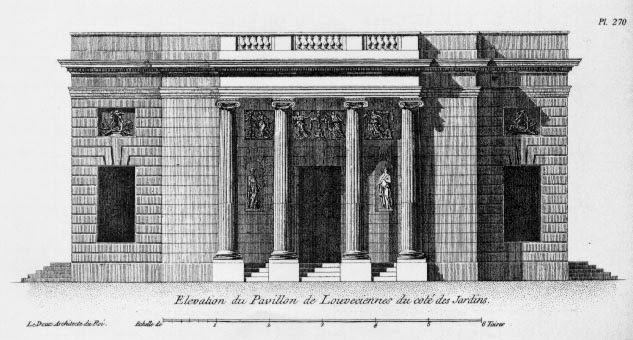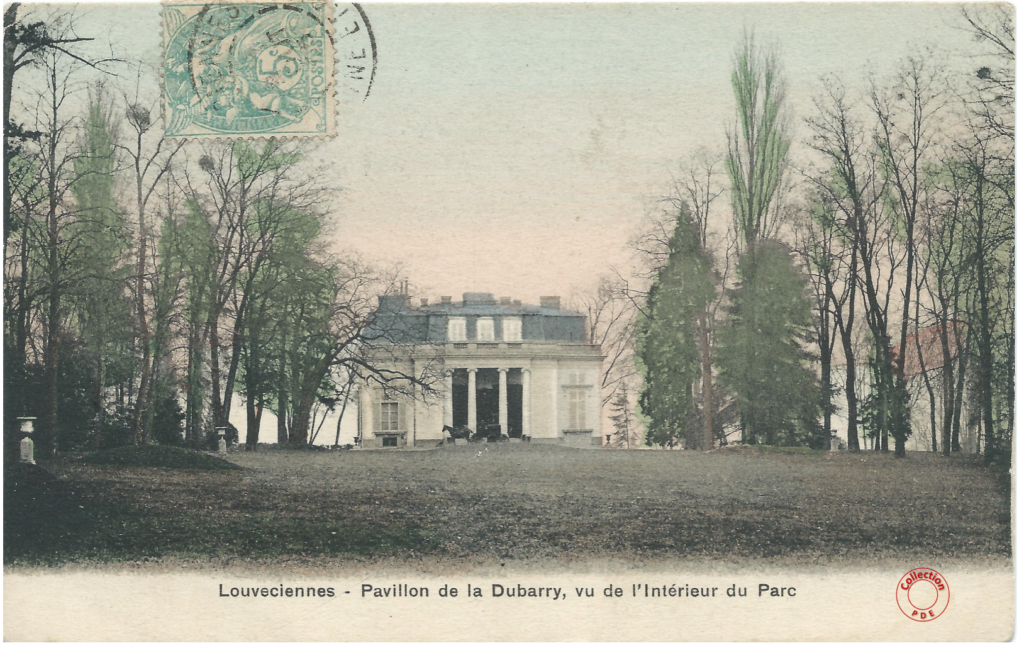Madame du Barry’s Pavillon de Musique for Sale
by habituallychic
03 . 08 . 22
Would you like to own an historic French chateau that can also earn you money as an event space? If so, I present the Pavillon de Musique in Louveciennes, France that can be your for 60,000,000 Euros.

Before I get to the details, I thought it would be interesting to outline how I came upon the Pavillon de Musique. I own the small etching on the top left. I bought it for $10 at Antiques on the Diamond in Ligonier, Pennsylvania around eight years ago. It depicts the Vue du Pavillon du Lucienne, près de Marly, appartenant à Madame la Comtesse du Bary (sic) par Bellet. A Google search after the purchase revealed that the same hand-colored engraving in a fancier frame sold at Christie’s in Paris for 2,750 Euros in April 2012. I could never find anything else about it online until just recently when I happened to be looking through the new book The French Royal Wardrobe: The Hôtel de la Marine Restored. I noticed a round engraving of the building in the book, Vue du Garde Meuble de la Couronne, center bottom image. It looked very similar to my etching and the book caption stated that the print was published in Vues Pittoresques des Principaux Edificies de Paris, 1787-1792. This was the missing link. When I Googled my etching again with this new information, I found out that my exact engraving can be found in the book, Fragonard’s Progress of Love by Alan Hollinghurst and Xavier F. Salomon published by The Frick Collection in association with D. Giles Limited. It’s funny that my etching has a connection to a museum that’s a few blocks away from my apartment and I didn’t even know it until now. It was when I was searching for the etching again that I found that the building depicted, the Château de Louveciennes, is currently for sale.

The Pavillon de Musique was built by architect Claude-Nicolas Ledoux on the initiative of Madame du Barry, King Louis XV’s last favorite mistress. It was intended as a reception space that she referred to as a folly because the chateau on property on the edge of the royal park at Marly did not have a view of the Seine.
Work on the Pavillon de Musique began in December 1770, with the structural work directed by entrepreneurs Lefaivre and Couesnon and was executed in just nine months. The exterior sculptures were executed by Feuillet and Métivier. The various salons are decorated by the greatest masters: Pierre Gouthière and Pierre Deumier chisel bronzes, François Boucher paints canvases, including the soaring ceiling of the music room Le Couronnement de Flore, as well as Jean-Honoré Fragonard who executed panels with the theme of The Four Moments of Love. These now reside in The Frick Collection.
In 1773, Madame du Barry, satisfied with her pavilion, commissioned from Ledoux the plans for a large castle, intended to envelop the small building, but the death of Louis XV in 1774 put an end to this project.
The Countess du Barry organized many receptions there until the Revolution. Refusing to go into exile, she was arrested on September 22, 1793 and then guillotined on December 8 of the same year. Her property is then confiscated and becomes national property.

No less than six owners succeeded each other until 1818, when banker Jacques Laffitte bought the property.
After the banker’s death in 1844, his widow had the estate divided into three parts: the castle, the pavilion, and the Lions estate in Bougival in 1850.
The Pavillon de Musique is sold to Dominique Héloin who resells it to Charles Louis Diericks, director of the Monnaie de Paris, after two years. He built a small guardian’s pavilion and after his death, his widow and heirs continued to reside there until 1871, when the pavilion was sold to Viscount de Janzé.
In 1878, the Viscount sold it to Alice Thal de Lancey who in turn sold it in 1911, in favor of Louis Loucheur who built a floor under attic attic, then disfiguring the initial work.

In 1929, perfumer François Coty bought the Pavillon de Musique. He had major work carried out since the pavilion had suffered serious deterioration due to too rapid construction, as well as the excessive weight exerted by the unfortunate addition of Louis Loucheur. François Coty called on architect Charles Mewès, son of Charles Frédéric Mewès, to move the building, which was then emptied of all its interior decorations and some exterior decorations. The rest of the building, too degraded, is completely destroyed and is rebuilt identically, about fifteen meters back, with a Saint-Leu stone facade embedded around a steel and concrete frame. The decorations are then all replaced and the attic floor is replaced in favor of an attic with a roof terrace, more harmoniously tuned to Claude-Nicolas Ledoux’s initial work.

In 1958, the Pavillon de Musique was acquired by the École Américaine de Paris, which sold it in 1971 to Victor Moritz, owner of the Tréca group, which gave many receptions and received many distinguished guests, politicians and artists from its entourage, including President Valéry Giscard d’Estaing.
Side note: In the 1980s, the château next door was acquired by a Japanese heiress, Nakahara Kiiko, and her Marseillais-born French-American husband illegally using the name of her family’s company Nippon Sangyo, as a commercial asset. The couple sold all the furniture and left the building abandoned. They were sued by the company later. Occupied by squatters, the château underwent various degradations. An attempt to remove the joinery and a chimneypiece was thwarted by the police. The owner then put the property up for sale, and it was bought by a French investor who carefully restored it.
In 1993, Julienne Dumeste donated the pavilion to her foundation and launched an extensive renovation project to meet her wish to open it to the public at exceptional events.
The work, which began in 2002, lasts three years. It first focuses on the exterior, then on the interior rehabilitation and upgrading necessary to open an establishment that can receive the public with strong security constraints, including technical infrastructure, respecting the two-year-old building and the preservation of its 4.6-hectare park.
In 2005, the first opening to the public after the work took place, on the occasion of the European Heritage Days.
The Pavilion de Musique was open for tours and rented out for events and weddings for many years.
In January 2019, the pavilion was closed to the public and offered for sale again.

The Louveciennes Pavillon de Musique is immediately considered one of Ledoux’s most accomplished achievements and one of the archetypes of neo-Paladianism.
The entrance, in the shape of an open semi-circular apse, simply closed by a peristyle, takes up a layout already used by Ledoux in Miss Guimard’s house on the Chausée d’Antin. It gives access to a room that has the shape of a square flanked by two semicircles, designated as a “dining room” and where the inauguration dinner took place. This room itself commissions a row of three lounges opening onto the Seine, including the central “King’s Lounge”.
In the basement, there were various service rooms and the kitchen.

Notable transformations occurred in the 19th and 20th centuries, including elevation of the building, by adding the attic which was later transformed into an attic housing five bedrooms. François Coty created rooms in the basement to install his perfumery laboratory, an electric generator, kitchens, and a swimming pool.

You can see the monogram of Madame du Barry on the door hardware.

The Pavillon de Musique opens into a large oval vestibule which was also used as a dining room. There is an enfilade of three adjoining salons beyond. Rising to the full height of the pavilion, the principal room was faced with light-grey marble and had tribunes at second-story level where musicians could play, although they complained of the cramped accommodations. Large mirrors were framed by pilasters, whose bronze and gold Corinthian capitals broke a frieze of playing children. The ceiling painting was by Boucher while over the door hung a portrait of Louis XV wearing the ribbon of the Holy Ghost order, a gift to his mistress in 1770.

A wider view of the dining room.

There is a description of the artwork from 1771 above from the book, A King’s favourite: Madame du Barry and her times:
“There is a water-colour in the Louvre, by the younger Moreau, depicting with sparkling cleverness a supper-party at Louveciennes. The composition of this delightful sketch may strike one as cold, so minute are its details from the squared marble of the floor to the gilded galleries for the musicians, which this evening were occupied by some of the guests of the Countess. Court etiquette was strictly followed in the serving of supper. Louis XV. presided, and the artist has cleverly caught the expression of haughty melancholy in his handsome Bourbon face. … To his right sits Madame Du Barry, in a very low-necked gown of white satin, with pearls about her throat, and her little head thrown proudly back, a pose that does not in the least detract from her charm and sweetness. Around the table great ladies are seated, and men glittering with orders ; Richelieu, the brilliant wit; courteous, reserved d’Aiguillon; caustic Maupeou; gentle and lovable Chauvelin; and among many others the young Viscount Du Barry, blind as ever to the radiant galaxy of women, to all but the favourite, his faithfully beloved aunt.
The footmen move with difficulty among the curious crowd. Madame Du Barry’s servants, in full dress livery of red velvet trimmed with gold lace, are aided in their duties by the Swiss Guards in blue uniform with white facings and edgings, three-cornered hats on their heads and swords by their side. Morin, the factotum, supervises their move- ments ; Zamore is also there, a little black page in a pink costume, and Mirza, the white greyhound, that the Abbé Delille had given the Countess. A flowery epergne adorns the centre of the table, and gold candelabra are placed among the piled dishes, masterpieces by Salanave, the favourite’s chief cook. Gold plate, chased by Roettiers de la Tour, alternates with Sevres ware, patterned with tiny flowers encircling the monogram of the Countess, a design by Saint- Aubin…”

Élisabeth Vigée Le Brun describes the salon during a visit to Louveciennes that she made to paint Madame du Barry’s portrait in 1786:
“In the evening we were usually alone at the fireside, Mme du Barry and I. She sometimes talked to me about Louis XV and his court…Every day after dinner we took coffee in the pavilion which was so famous for its rich and tasteful decorations. The first time Mme du Barry showed it to me she said: “It was here that Louis XV did me the honour of coming to dinner. There was a gallery above for musicians and singers who performed during the meal.” The salon was ravishing; besides enjoying the most beautiful view in the world, the chimneypieces, the doors, everything was of the most precious work, even the locks could be admired as chefs-d’oeuvre of the goldsmith’s art, and the furniture was of a richness and elegance beyond description.”
In 1786, however, it was no longer Louis XV who enjoyed a siesta here but Madame du Barry’s faithful lover of latter years, the Duc de Brissac (later to be cruelly lynched by a Versailles mob and have his head unceremoniously lobbed through Madame’s open drawing room window).

The ceiling by Boucher.

The room directly behind the Salle a Manger is the Salon du Roi which is the main salon that opens out to the terrace overlooking the Seine.

The blog Rodama1789 has great descriptions of the rooms
“Decorative highlights by the ever industrious Gouthière included intertwining vine-leaves above the twin fire-places, and flower-work features not only in the panels, brackets and embrasures but also in sash-fastenings, locks and door-knobs. The magnificent ormolu fire-irons are no longer in situ, though apparently an original still exists at the Château de Compiègne. Expensive figured Gobelin tapestries, with themes after Vien, once adorned the panels and the famous bust of the favorite by Pajou resided on an altar of white marble, gold and silver (a copy now sits somewhat more prosaically on one of the mantelpieces), Straight-legged neoclassical chairs by Louis Delanois, from this room and elsewhere in the pavilion, can be found in various museums and still turn up from time to time at auction.”

To the right of the Salon du Roi is the now referred to as the Salon Ledoux, was known as the salon cul-de-four in the 18th century (for its curved walls).

Supposedly, it was here that Fragonard’s gorgeous series of paintings, The Progress of Love, had been intended to hang. Madame du Barry commissioned Joseph-Marie Vien to paint another series of paintings on the theme of the Progress of Love painted in a neoclassical style that is more fashionable and more suitable for the decor she created in Louveciennes.

Le Salon Fragonard sits to the left of the Salon du Roi. Madame du Barry commissioned Jean-Honoré Fragonard for a series of four large paintings for her pavilion. Made between 1771 and 1772, Les Progrès de l’amour, evoked in a Rococo style the four moments of love, but the paintings displeased Madame du Barry, and she then refused the commission. There is some speculation as to the reason. One theory is because she thought the male figures in the paintings resembled King Louis XV but everyone knew she was his favorite so not sure why that would have mattered.
After du Barry rejected them, Fragonard took them back and put them in storage for over twenty years.
In 1790, during the French Revolution, he returned to his hometown of Grasse, he installed the ensemble in the living room of one of his cousins, Alexandre Maubert. His grandson sold them in 1898 in favor of the great collector J.P. Morgan. According to René Gimpel, the sale was made through the Parisian antique dealer Guiraud Sr., who after having unsuccessfully offered them, among others to Edmond de Rothschild, sells them to him with a profit of 10%. J.P. Morgan presented them in his residence in London and then at the Metropolitan Museum of Art before offering them for $1,250,000 to art dealer Joseph Duveen, who negotiated them for $1 million to resell them at the price originally asked Henry Clay Frick. According to other sources, Frick acquired them upon Morgan’s death for $1,250,000 million.
They are now one of the jewels of The Frick Collection in New York, where a room is dedicated to them.

A little living room is included for this ground floor. Two boudoirs complete the lower-ground floor. The second floor comprises meeting rooms, study rooms, and WC. In the basements are technical areas, WC, cellars, and store rooms.

The Pavillon de Musique sits in the middle of a park that was designed in the 19th century.

The side of the Pavillon de Musique towards the Seine is known from a drawing made by the British neoclassicist Sir William Chambers. In Chambers’ drawing, unlike Ledoux’s commemorative engraving (illustration above), its three central bays project in the accustomed Gabriel manner, with attached Ionic columns and bas-relief panels above the severely plain window openings; in the flanking single bays the windows have plain entablatures surmounted by low plinths of concave profile.

The 400 square meter terrace, overhanging the Seine, offers panoramic and inescapable views on the Eiffel Tower, La Défense, and Le Mont Valérien.

The Pavillon de Musique borders the Chemin de la Machine, a favorite subject of the Impressionists Camille Pissarro and Alfred Sisley.

An old carte postal of the view from the terrace.

Another view from the terrace.

In 1772, to decorate the park, Louis XV gave Madame du Barry the Bather, which Christophe-Gabriel Allegrain had exhibited in the Salon of 1767. In 1776, Madame du Barry commissioned from Allegrain a pendant bather, completed in 1778; as Vénus and Diane they offered an allegory of sensuous and of chaste love. Both are now conserved in the Louvre Museum.

The plan for the Pavillon de Musique and garden.

In 1852, the property was expanded to the banks of the Seine, but was divided into two lots. The first, including the château, was acquired by the banker Solomon Goldschmidt, whose heirs had it built upon by the architect Henri Goury, in 1898. The entry was in the Louis XV style, flanking the two houses, located at 6 chemin de la Machine. The same architect also built the stables.

The second lot included the Pavillon de Musique by Ledoux, equipped with two entries built by the architect Pasquier (one, located at 28 route de la Princesse and the other in Rennequin-Sualem quay in Bougival); it was acquired by a rich American from Baltimore, Alice Thal de Lancey, mistress of the banker Nissim de Camondo, who had met her through Arthur Meyer. Edmond de Goncourt made fun of “the ironic interior of Louveciennes, where Madame du Barry lived and where lives today Madame de Lancey and where the banker Camondo replaces Louis XV.”

There isn’t much information about the garden that I could find online.

The view of the Pavillon de Musique from the fountain.

An old photo of the same view.

A tennis court is included on the property.

This gives you a look at the overview of the property.

The same overview with satellite.

Nestled in a 5,7 ha park with English gardens, this exceptional and historic property comprises the 1,355 square meter Pavillon de Musique, the 275 square meter Pavillon d’Accueil including two apartments, a 62 square meter accommodation located in the former stud farm, and two 39 square meter garages.

If you end up buying the Pavillon de Musique, please invite me for a visit.




